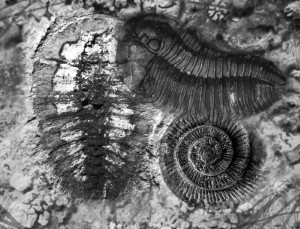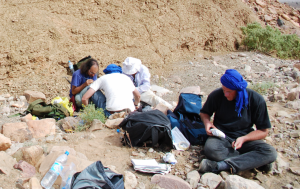Around 490 million years ago, the oceans of the Earth were not diverse environments as they are today. Though the Cambrian Explosion some 40 million years earlier had led to the appearance of most major phyla of animals, each phylum still contained relatively few orders and families. However, over the next 25 million years, the array of life on Earth would grow at a rate that has never since been matched, with the number of taxonomic families tripling. Accompanying this hike in biodiversity was a dramatic increase in behavioral complexity. This “filling out” of animal phyla is now known as the Great Ordovician Biodiversification Event (GOBE). Peter Van Roy, of the Yale Department of Geology and Geophysics, calls it an event that is “in importance certainly on par with the Cambrian explosion.”
Despite the clear significance of such a major radiation, scientists know quite little about the GOBE since most fossil sites that date to the GOBE preserve only shelled animals; soft-bodied animals, which constitute the majority of most faunas. However, these normally decay very quickly and hence, are only very rarely preserved. But, new exceptional fossil sites from Morocco that have preserved soft tissues are currently under study by Van Roy and Derek Briggs, also of the Yale Department of Geology and Geophysics. These sites are revealing a wealth of new information about this critical era in animal evolution.

The Moroccan fossil sites belong to two formations, the Upper and Lower Fezouata Formations, which were discovered in 2002 by Mohammed Ben Said Ben Moula, a local fossil collector who now collaborates with Van Roy and Briggs. The two formations span hundreds of square kilometers, and exceptionally-preserved fossils can be found through a thickness of about 700 meters of ancient sediments. They are distinguished by their impressive array of soft-bodied fossils from the ancient sea floor, unlike any previously found from the GOBE time period. The wide distribution of the Fezouata rocks is also important, since it allows researchers to study the evolution over time and to discern “slight differences in faunas which are both environmentally and temporally related,” as stated by Van Roy.
Some of the fossils found at Fezouata resemble animals from the Burgess Shale, an older exceptionally preserved fauna from Canada that dates back to the Middle Cambrian. These Cambrian-era “Burgess Shale-type” faunas were thought to have gone extinct by the end of the Middle Cambrian, before the start of the GOBE, but the Fezouata fossils clearly show that this was not the case. Instead, it appears that these older Cambrian faunas coexisted for a time with animals that are more typical of later Paleozoic biotas. This coexistence points to a protracted replacement of Cambrian faunas, rather than the rapid turnover that previous theories describe.
The Fezouata Biota is also unique for paleogeographic reasons. It preserves sites that, 480 million years ago, would have been almost exactly at the Earth’s South Pole, indicating a cold marine setting. In contrast, all exceptional fossil deposits of Cambrian age were near the equator at the time they were formed. Consequently, the Fezouata Biota provides the first evidence that the marine Burgess Shale-type communities were not restricted to the Early and Middle Cambrian but were, according to Van Roy, “a kind of normal deep-water fauna which was globally pervasive at least in the Early Paleozoic.”
The Fezouata sites continue to be excavated, and hundreds of specimens remain to be processed. Many further discoveries may yet emerge from this wonderfully-preserved window into the depths of a little-known, yet very important, geological era.

